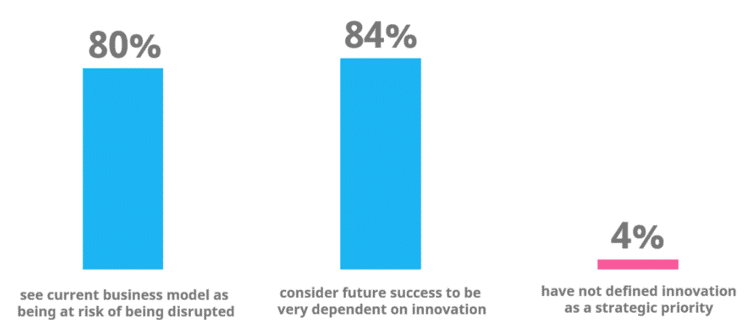Innovation Management: What is it? (and why you should care)

You Can’t Fix It If You Don’t Know It’s Broken
A study by VIIMA showed that 80% of executives consider their future success to be dependent on Innovation and 84% said that they are risk of their current business model being disrupted. With that in mind, 96% of executives have now defined Innovation as a strategic priority… But how successful are organizations since ‘defining’ it? The same research showed that only 6% of executives are satisfied with their innovation performance and one could only imagine the perception of employees on the frontline. Why such a big gap between intent and performance? Organizations are identifying that innovation is important…but they suck at it. If this is such a big threat, how then do organizations close the gap between seeing the problem and ‘fixing’ how they innovate?

VIIMA Innovation Stats
Surviv(or) Die!

The one goal of any organization is to survive. Successful organizations become successful by repeatedly solving a problem and they grow by getting better at solving that problem. To do this, organizations develop management systems that create and reinforce employee habits. These management systems are designed to be consistent and therefore, successful. To be successful, organizations develop strategies to improve these existing systems. The authors of ‘Eat, Sleep, Innovate’, Scott D. Anthony, Paul Cobban, Natalie Painchaud and Andy Parker, sum this up beautifully by saying “in a stable world, engrained habits reinforced by systems and structures serve as a source of strength. But in a changing world…a blind adherence to these habits can be harmful as institutionalized inertia inhibits necessary change.” This serves as a fundamental paradox as organizations are unintentionally preventing themselves from thinking outside the box because they’re focused on building faster horses rather than come up with the idea for a car (there’s a butchered Henry Ford quote in there somewhere). The way organizations are traditionally managed prevents creativity and therefore, Innovation. So if most organizations consider their success to be dependent on Innovation and are nervous of being disrupted, how can they make Innovation performance the ‘norm’?
What if innovation was managed in the traditional sense, as a system?
Innovation Management
Innovation Management is a relatively new holistic approach to Innovation that considers both internal and external functions within the organization. It becomes more than just creating new products to sell. It becomes the way in which business is conducted. Turning Innovation into a management system allows organizations to be creative but with intent, with dedicated processes that deliver consistent results.
Innovation Management also builds resiliency and capacity for failing successfully. Organizations turn into an iterative loop of improvement and solutions start to consider the big picture which means they’re sustainable, not band-aid fixes that come from constantly reacting to day-to-day problems.
What does this mean for employees? It’s inherent in employees to want to bring all their capabilities to work each day. Current management principles however, place little value on creativity, initiative and passion, more so on discipline, punctuality, rationality and order. When Innovation becomes part of how business is done, it starts to happen naturally where employees WANT to contribute. Employees start to feel fulfilled because they are constantly being challenged. They also feel heard because they’re being asked for their ideas on how to improve what they work on every day and employees who feel heard tend to hang around for longer, are happier, more motivated and therefore confident in the direction of the organization.
Overall, Innovation Management becomes the reality check that every organization’s strategy needs to survive.
…But You Can’t Systemize Innovation!

Some might say Innovation can’t be a system because it kills the essence of what creativity is all about and you can’t force creativity… I agree that you can’t force creativity in the sense of giving someone a paintbrush and asking them to paint like Van Gogh. But innovation or ‘creativity’, in the business sense, is not about hiring people who can paint (unless that’s your business), it’s about encouraging employees to come up with ideas based on their experiences, making them feel comfortable to share those ideas, then acting on their ideas. Creativity within an organization is about removing barriers, not about handing out paint brushes.
Claiming that Innovation shouldn’t be managed as a system is like saying there’s no need for Quality Management, we should just cross our fingers and hope for the best. Innovation Management, like Quality, acts as the guideposts to support better decision making and approaches to foster Innovation within the people and processes of an organization. It’s not a program or a discipline. It’s shifting the organization’s culture to focus on creating an environment of fulfillment for every employee.
Where To Start?
Is your organization reactive to your competition? Do you think Innovation is only about creating new products? Do you have a way to capture ideas from employees, but no ideas are being shared? The best way to start your Innovation Management journey is to understand where you are at currently. At Unbounded, we created four areas of Innovation to help. Within each area we focus on where people are with their understanding of Innovation, what process and tools are in place to support innovative efforts and finally, how ideas are captured, what content is being produced and how successful it is at being repeated.

Unbounded Thinking Innovation Management
Download the full infographic here.
We typically live in one of the four stages of innovation seen in the infographic below. These stages aren’t rigid though, meaning you might have some structure when it comes to Innovation, but no one in the organization knows what it is. With that in mind, it’s more important to know how to improve and that there are ways to do it. If you work in an organization that has no processes in place and everyone is confused at the direction of the business (Random Innovation) then it allows you to understand your current state and identify where to go next. This allows you to develop an Innovation Management system that is right for your current state and your business, along with being able to set goals to improve.
The Future Is Bright

ISO (the International Organization for Standardization) is a worldwide federation of national standards bodies (ISO member bodies) who have recently developed the 56000 family of standards for Innovation Management. This is exciting as Innovation Management is now being recognized as a similar management system to all others, including Quality, Risk, Safety, Environmental and many others. Check out ISO 56002:2019 Innovation Management for a sneak peak of the standard.
It’s only a matter of time before Innovation Management becomes the new ‘standard’ at your organization. Are you going to react to your competition or lead the way?
